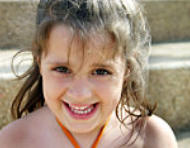



(818) 932-9644
Creative Behavioral Consultants, Inc.
4500 Park Granada Blvd., Suite 202
Calabasas, CA 91302


Autism Facts
Autism is a developmental disability that generally appears
during the first three years of life. The specific cause of Autism
still remains a mystery but researchers are looking for answers.
It is a complex neurological disorder that affects each
diagnosed individual differently.
The behaviors can manifest themselves in a variety of ways, but
generally the disorder is characterized by impairments in
language, difficulties relating to others, and behaviors that
include repetition and rigid routines. Typically, children do not
"outgrow" Autism, but empirical data shows that it is treatable
using Applied Behavior Analysis. Studies demonstrate that early
diagnosis and intervention lead to significantly improved
outcomes. Having CBC assess your child leads to the
collaborative creation of an individualized treatment plan.
Behavior intervention services are then scheduled and provided
in your home or in your child’s classroom, along with
personalized parent and caregiver training.
Statistics
In 2023, the CDC reported that approximately 1 in 36 children in
the U.S. is diagnosed with an autism spectrum disorder (ASD),
according to the study. Boys are four times more likely to be
diagnosed with autism than girls.
Source: Centers for Disease Control and Prevention (2023)
•
1 in 36 children in the U.S. have autism, up from the
previous rate of 1 in 44.
•
1 in 45 adults in the U.S. have autism.
•
In the U.S., about 4 in 100 boys and 1 in 100 girls have
autism.
•
Boys are nearly 4 times more likely to be diagnosed with
autism than girls.
•
Autism prevalence:
•
White – 2.4%
•
Black – 2.9%
•
Hispanic – 3.2%
•
Asian or Pacific Islander – 3.3%
Autism Prevalence
What Causes Autism
•
Research indicates that genetics are involved in the vast
majority of cases.
•
Children born to older parents are at a higher risk for having
autism.
•
The chance of a second child having ASD is over 10
percent.
•
Studies have shown that among identical twins, if one child
has autism, the other will be affected about 60 to 90 percent
of the time. Fraternal same sex twins is 34 percent of the
time. Boy-girl pairs are 18 percent.
•
Vaccines do not cause Autism.
Myths About Autism
Myth: Individuals with Autism are not capable of learning.
Fact: All individuals with Autism can learn. If the individual is
not learning, it is probably because the teaching methodology
is not working and needs to be changed. The key is figuring
out how the child learns and matching the best teaching
methodology to their individual style of learning.
Myth: Most individuals with Autism never
learn to talk.
Fact: With early diagnosis and
intervention, many individuals with Autism
develop very good language skills. Even
those who are non-verbal can develop
other ways of communicating using tools
such as sign language and augmentative or picture
communication systems. Early intervention is essential as the
likelihood of speech development diminishes after age five.



Myth: Individuals with Autism are
unable to feel emotions or develop
personal relationships.
Fact: Although sometimes a child with
Autism may not express affection in a
more conventional way, the majority of
children diagnosed with Autism are
able to show love and affection, form
attachments and develop strong
connections with others.
Myth: Someone who has Autism does
not make eye contact with others.
Fact: This can be a challenging skill
for someone diagnosed with ASD, but
many individuals with ASD can learn
how to maintain eye contact.



Creative Behavioral Consultants
4500 Park Granada Blvd., Suite 202
Calabasas, CA. 91302
(818) 932-9644

ABA and Autism
Treatment Specialists
Autism Facts
Autism is a developmental disability that generally appears
during the first three years of life. The specific cause of Autism
still remains a mystery but researchers are looking for
answers. It is a complex neurological disorder that affects
each diagnosed individual differently.
The behaviors can manifest themselves in a variety of ways,
but generally the disorder is characterized by impairments in
language, difficulties relating to others, and behaviors that
include repetition and rigid routines. Typically, children do not
"outgrow" Autism, but empirical data shows that it is treatable
using Applied Behavior Analysis. Studies demonstrate that
early diagnosis and intervention lead to significantly improved
outcomes. Having CBC assess your child leads to the
collaborative creation of an individualized treatment plan.
Behavior intervention services are then scheduled and
provided in your home or in your child’s classroom, along with
personalized parent and caregiver training.
Statistics
In 2020, the CDC reported that approximately 1 in 54 children in
the U.S. is diagnosed with an autism spectrum disorder (ASD),
according to 2016 data. Boys are four times more likely to be
diagnosed with autism than girls.
Statistics
Autism Prevalence
What Causes Autism
•
Research indicates that genetics are involved in the vast
majority of cases.
•
Children born to older parents are at a higher risk for having
autism.
•
The chance of a second child having ASD is over 10
percent.
•
Studies have shown that among identical twins, if one child
has autism, the other will be affected about 60 to 90 percent
of the time. Fraternal same sex twins is 34 percent of the
time. Boy-girl pairs are 18 percent.
•
Vaccines do not cause Autism.
Myths About Autism
Myth: Individuals with Autism are not capable of learning.
Fact: All individuals with Autism can learn. If the individual is not
learning, it is probably because the teaching methodology is not
working and needs to be changed. The key is figuring out how
the child learns and matching the best teaching methodology to
their individual style of learning.
Myth: Most individuals with Autism
never learn to talk.
Fact: With early diagnosis and
intervention, many individuals with
Autism develop very good language
skills. Even those who are non-verbal
can develop other ways of
communicating using tools such as sign language and
augmentative or picture communication systems. Early
intervention is essential as the likelihood of speech development
diminishes after age five.
Myth: Individuals with Autism are unable to feel emotions or
develop personal relationships.
Fact: Although sometimes a child with Autism may not express
affection in a more conventional way, the majority of children
diagnosed with Autism are able to show love and affection, form
attachments and develop strong connections with others.
Myth: Someone who has Autism does not make eye contact with
others.
Fact: This can be a challenging skill for someone diagnosed
with ASD, but many individuals with ASD can learn how to
maintain eye contact.

Source: Centers for Disease Control and Prevention (2023)
•
1 in 36 children in the U.S. have autism, up from
the previous rate of 1 in 44.
•
1 in 45 adults in the U.S. have autism.
•
In the U.S., about 4 in 100 boys and 1 in 100
girls have autism.
•
Boys are nearly 4 times more likely to be
diagnosed with autism than girls.
•
Autism prevalence:
•
White – 2.4%
•
Black – 2.9%
•
Hispanic – 3.2%
•
Asian or Pacific Islander – 3.3%





























